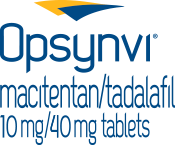
This site is intended for
U.S. healthcare professionals
For the chronic treatment of adults with pulmonary arterial hypertension (PAH, WHO Group I and WHO Functional Class [FC] II-III)1
Science Liaison (MSL)Contact your MSL
OPSYNVI® (macitentan/tadalafil) was proven to reduce PVR more than tadalafil monotherapy or macitentan monotherapy. Most common adverse reactions are edema/fluid retention (21%), anemia (19%), and headache/migraine (18%).1
Actor
portrayals.
OPSYNVI® (macitentan/tadalafil) was proven to reduce PVR more than tadalafil monotherapy or macitentan monotherapy. Most common adverse reactions are edema/fluid retention (21%), anemia (19%), and headache/migraine (18%).1
OPSYNVI®—the first and only US FDA-approved single-tablet dual-combination therapy for PAH1,2
Part of the PAH portfolio by Johnson & Johnson—
OPSYNVI® targets 2 of the foundational pathways: Endothelin and nitric oxide.1,3
FDA=US Food and Drug Administration; PVR=pulmonary vascular resistance; WHO=World Health Organization.
References: 1. OPSYNVI® (macitentan/tadalafil) full Prescribing Information. Actelion Pharmaceuticals US, Inc. 2. Grünig E, Jansa P, Fan F, et al. Randomized trial of macitentan/tadalafil single-tablet combination therapy for pulmonary arterial hypertension. J Am Coll Cardiol. 2024;83(4):473-484. 3. Humbert M, Kovacs G, Hoeper MM, et al; ESC/ERS Scientific Document Group. 2022 ESC/ERS Guidelines for the diagnosis and treatment of pulmonary hypertension: the Task Force for the Diagnosis and Treatment of Pulmonary Hypertension of the European Society of Cardiology (ESC) and the European Respiratory Society (ERS). Eur Heart J. 2022;43(38):3618-3731. 4. Galié N,Brundage BH, Ghofrani HA, et al; Pulmonary Arterial Hypertension and Response to Tadalafil (PHIRST) Study Group. Tadalafil therapy for pulmonary arterial hypertension. Circulation. 2009;119(22):2894-2903. 5. Pulido T, Adzerikho I, Channick RN, Delcroix M, et al; SERAPHIN Investigators. Macitentan and morbidity and mortality in pulmonary arterial hypertension. N Engl J Med. 2013;369(9):809-818 and suppl 1-21. doi:10.1056/NEJMoa1213917




